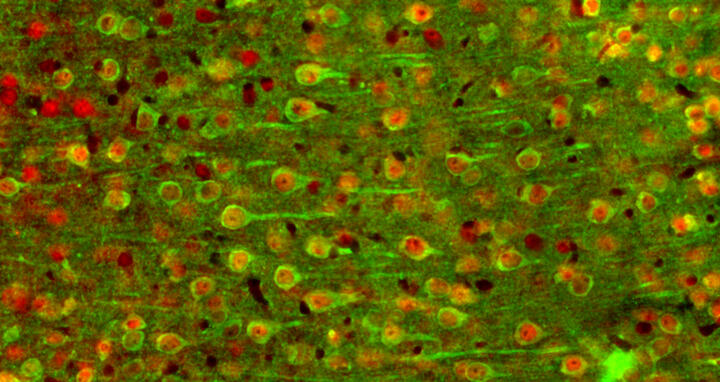How the brain encodes warm and cool
A hot coffee, a cold soda — our ability to detect the temperature of objects is crucial for surviving the world. For almost a century, scientists have tried to pinpoint where in the brain the ability to sense temperatures is located. Some have suggested there is a distinct ‘thermal cortex’, but the presence of a specific region has been debated — until now.
Researchers at the Max Delbrück Center in Berlin have identified a thermal cortex in the brain of mice, and identified nerve cells (or ‘neurons’) that detect cool or warm temperatures. Their research was published in the journal “Nature”.
Understanding how the brain works is a final frontier of science, and investigating sensory perception is a good way of trying to do that.
“Understanding how the brain works is a final frontier of science, and investigating sensory perception is a good way of trying to do that,” says Professor James Poulet, a neuroscientist at the Max Delbrück Center and Charité – Universitätsmedizin, who led the research team. “There are unfortunately many brain diseases without cures, including ones that alter sensory perception. In the long run, understanding how circuits of nerve cells work in the healthy brain will help fix the diseased brain.”
As a person moves through the world, the brain processes information flowing from the sense organs to construct a conscious perception of the world. Much of this happens in the outer folded layer of the brain, called the cortex. Poulet and his team have previously found that neurons in the primary somatosensory cortex respond when the skin comes in contact with cool temperatures. So, they expected that warm temperatures would also be encoded in this region.
Specific neurons respond to cool and warmth
Dr. Mikkel Vestergaard and Dr. Mario Carta, co-first authors and researchers in Poulet’s Neural Circuits and Behaviour lab, tested this hypothesis in mice, whose brains are similar to humans. They delivered mild temperatures to the animals’ forepaws and used imaging techniques to discover which part of the brain responded to changes in skin temperature.
To their surprise, the scientists found that the primary somatosensory cortex did not respond to warmth. When they looked around further, they found neurons responding in a region at the side of the brain called the posterior insular cortex. “Our study shows that the posterior insular cortex seems to contain the elusive thermal cortex,” Carta says.
They then used a two-photon microscope to look at the response of individual neurons in the posterior insular cortex. “We found that there are specific cold-responding neurons and specific warm-responding neurons, as well as many that responded to both warm and cool,” Vestergaard says.
The averaged widefield calcium imaging shows how the posterior insular cortex responds to cool (left) and warm (right) stimulation of the mouse’s forepaw.
The warm and cold neurons reacted quite differently. Warm neurons responded to the absolute temperature, while cold neurons responded to the relative change in temperature. The cold responses were also activated more quickly and died down sooner than the warm responses. “This indicates that there might be separate pathways for the perception of cold versus warm,” Vestergaard says.
The flow of temperature
To conclusively prove the insular cortex is involved in temperature perception, the scientists trained the mice to report either cool or warm temperatures. Then they used the technique of optogenetics to temporarily deactivate the posterior insular cortex while delivering a thermal stimulus. “When we did this, the mouse didn't feel the temperature stimulus,” Poulet says. When the scientists stopped suppressing this part of the cortex, the mouse again felt the sensation.
Epifluorescence image of the mouse posterior insular cortex with neurons expressing a calcium sensitive protein in green and a general neuronal marker in red.
In the future, the Poulet team plans to study the pathway of temperature flow from the skin, via the spinal cord into the thalamus and finally into the cortex. “We're looking at different stations to see where and how the temperature information is represented and how it is transformed along the pathway,” he says.
They are also studying one of the bigger puzzles of this study: why is the primary somatosensory cortex, which perceives cold, not responsive to warmth? The scientists theorize that this region could be responsible for perception of complex textures, such as dampness, smoothness or metallic. “It could be that the cold representation in the somatosensory cortex is somehow helping the discrimination of complex surface structure,” Poulet says. “We need to do more experiments to really understand. It’s fascinating, and still rather unclear.”
gan
Further information
Literature
Mikkel Vestergaard, Mario Carta et al. (2023): “The cellular coding of temperature in the mammalian cortex”, Nature, DOI: 10.1038/s41586-023-05705-5
Photos to download
The averaged widefield calcium imaging shows how the posterior insular cortex responds to cool (left) and warm (right) stimulation of the mouse’s forepaw. Photo: Mikkel Vestergaard, Poulet Lab, Max Delbrück Center
Epifluorescence image of the mouse posterior insular cortex with neurons expressing a calcium sensitive protein in green and a general neuronal marker in red. Photo: Mikkel Vestergaard, Poulet Lab, Max Delbrück Center
Contacts
Prof. Dr. James Poulet
Head of the Lab “Neural Circuits and Behaviour”
Max Delbrück Center
+49-(0)30-9406-2335
james.poulet@mdc-berlin.de
Jana Schlütter
Editor, Communications Department
Max Delbrück Center
+49-(0)30-9406-2121
jana.schluetter@mdc-berlin.de or presse@mdc-berlin.de
- Max Delbrück Center
-
The Max Delbrück Center for Molecular Medicine in the Helmholtz Association (Max Delbrück Center) is one of the world’s leading biomedical research institutions. Max Delbrück, a Berlin native, was a Nobel laureate and one of the founders of molecular biology. At the locations in Berlin-Buch and Mitte, researchers from some 70 countries study human biology – investigating the foundations of life from its most elementary building blocks to systems-wide mechanisms. By understanding what regulates or disrupts the dynamic equilibrium of a cell, an organ, or the entire body, we can prevent diseases, diagnose them earlier, and stop their progression with tailored therapies. Patients should be able to benefit as soon as possible from basic research discoveries. This is why the Max Delbrück Center supports spin-off creation and participates in collaborative networks. It works in close partnership with Charité – Universitätsmedizin Berlin in the jointly-run Experimental and Clinical Research Center (ECRC), the Berlin Institute of Health (BIH) at Charité, and the German Center for Cardiovascular Research (DZHK). Founded in 1992, the Max Delbrück Center today employs 1,800 people and is 90 percent funded by the German federal government and 10 percent by the State of Berlin.








